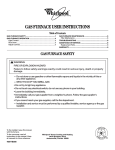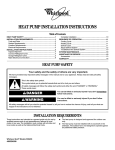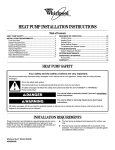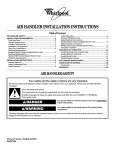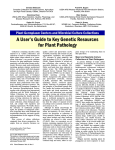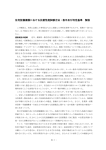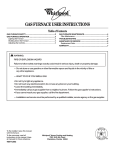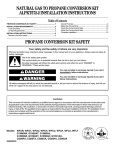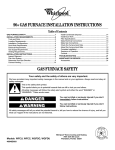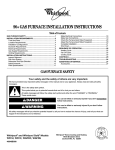Download Whirlpool GOLD W4GH6 Unit installation
Transcript
CONDENSING UNIT INSTALLATION INSTRUCTIONS Table of Contents CONDENSING UNIT SAFETY........................................................1 INSTALLATION REQUIREMENTS ................................................1 Tools and Parts ............................................................................2 System Requirements..................................................................2 Location Requirements ................................................................2 Electrical Requirements ...............................................................3 INSTALLATION INSTRUCTIONS ..................................................4 Inspect Shipment .........................................................................4 Flush Refrigerant Lines ................................................................4 Connect Refrigerant Lines ...........................................................6 Charge Refrigerant Lines .............................................................8 Make Electrical Connections .....................................................10 Complete Installation..................................................................12 SEQUENCE OF OPERATION ......................................................12 TROUBLESHOOTING ..................................................................12 System Diagnostic Module ........................................................12 SYSTEM MAINTENANCE ............................................................14 ASSISTANCE OR SERVICE .........................................................14 Accessories ................................................................................14 WARRANTY ..................................................................................15 CONDENSING UNIT SAFETY Your safety and the safety of others are very important. We have provided many important safety messages in this manual and on your appliance. Always read and obey all safety messages. This is the safety alert symbol. This symbol alerts you to potential hazards that can kill or hurt you and others. All safety messages will follow the safety alert symbol and either the word “DANGER” or “WARNING.” These words mean: DANGER WARNING You can be killed or seriously injured if you don't immediately follow instructions. You can be killed or seriously injured if you don't follow instructions. All safety messages will tell you what the potential hazard is, tell you how to reduce the chance of injury, and tell you what can happen if the instructions are not followed. INSTALLATION REQUIREMENTS These instructions are intended as a general guide only for use by qualified persons and do not supersede any national or local codes in any way. The installation must comply with all state and local codes as well as the National Electrical Code. Whirlpool Gold® Model W4GC6 48487D008 ■ ■ The condensing unit is designed and approved for outdoor use only. The condensing unit must be installed with no ductwork in the airstream. The outdoor fan is not designed to operate against any additional static pressure. Indoor System Thermal Expansion Valve Tools and Parts Gather the required tools and parts before starting installation. Read and follow the instructions provided with any tools listed here. Tools Needed ■ ■ ■ ■ ■ W4GC6 units are designed for use with thermal expansion valve systems only. The thermal expansion valve must be ordered separately from the manufacturer. Thermal Expansion Valve Kits Torch ¹⁄₄" nut driver ⁵⁄₁₆" nut driver Adjustable wrench ■ ■ ■ Gauge set for R-410A refrigerant Service wrench with hexhead extension Torque wrench Model Part Number W4GC624 A4TXV01 W4GC636 A4TXV02 W4GC648, W4GC660 H4TXV03 Parts Needed Check local codes and HVAC supplier. Check existing electrical supply, and read “Electrical Requirements,” “Location Requirements,” “System Requirements” and “Connect Refrigerant Lines.” NOTE: Some condensing units do not contain a factory-installed filter dryer. With those units, a properly sized filter dryer must be field installed in the liquid (high pressure) line set between the outdoor condensing unit and indoor evaporator unit. Location Requirements ■ ■ System Requirements Condensing unit system matches are derived from actual laboratory testing of matched systems. It is recommended that only matching equipment be used to ensure proper operation and efficient performance. ■ The designed system matches are listed in the condensing unit specification sheets. Refrigerant charging instructions are located on the back of the service access panel. ■ This condensing unit has been factory charged with a quantity of refrigerant (R-410A) sufficient for a matched indoor coil and a maximum 15 ft (4.6 m) of refrigerant line. ■ In order to maintain the SEER rating, this condensing unit must be matched to an indoor section containing a variable speed blower. ■ Refer to the Thermal Expansion Valve Kits chart to determine the correct size thermal expansion valve required. ■ This product has been designed and manufactured to meet ENERGY STAR® criteria for energy efficiency when matched with appropriate coil components. However, proper refrigerant charge and proper airflow are critical to achieve rated capacity and efficiency. Installation of this product should follow the manufacturer’s refrigerant charging and airflow instructions. Failure to confirm proper charge and airflow may reduce energy efficiency and shorten equipment life. ■ A filter dryer approved for use with R-410A refrigerant is installed in the condensing unit. ■ If this condensing unit is equipped with a crankcase heater, it should be energized 24 hours before the condensing unit is started to avoid compressor damage as a result of slugging. ■ Use only polyol ester oils if oil must be added to the system. Mineral oil is not compatible with refrigerant. ■ ■ ■ This condensing unit is designed to be located outdoors with sufficient clearance for free entrance to the inlet and discharge air openings. The location must also allow for adequate service access. See “Minimum Clearances.” Where possible, select a location for the condensing unit which is shaded from the direct rays of the sun most of the time. North or east locations are usually most desirable. Position the condensing unit to avoid direct contact with water, snow or ice from a roofline overhead. The condensing unit must be installed on a solid, level mounting pad that will not settle or shift. Isolate the pad from the building structure to avoid possible transmission of sound or vibration from the condensing unit into the conditioned space. The condensing unit foundation should be raised to a minimum of 3" (7.6 cm) above finish grade. In areas which have prolonged periods of temperatures below freezing, and/ or snowfall, the condensing unit should be elevated above the average snow line. Avoid placing the condensing unit near areas such as sleeping quarters or study rooms. Normal operating sound levels may be objectionable if the condensing unit is placed near certain rooms. Minimum Clearances A B 48" (121.9 cm) Overhead Clearance (Discharge Air) ) m ) c 5 ir . 30 t A " ( le 12 e (In nc ra ea Cl E D F G H Cl 36 ea " ra (91 nc .4 e ( cm Inl ) et Ai r) ice erv ce S ) n cm ra .2 lea 76 ss C ( " 30 cce A A. Weatherproof disconnect switch B. NEC class 1 wiring C. NEC class 2 wiring D. To power supply 2 C 12" (30.5 cm) Clearance Between Unit and Building E. House thermostat F. To indoor unit G. To indoor coil H. Seal openings Line Set Isolation The following illustrations demonstrate procedures which ensure proper refrigerant line set isolation. IMPORTANT: Refrigerant lines must not contact structure. B Installing Horizontal Runs A C This shows how to install line sets on horizontal runs. NOTES: ■ To hang line set from joist or rafter, use either metal strapping material or anchored heavy nylon wire ties. ■ Strap the vapor line to the floor joist or roof rafter at 8 ft (2.4 m) intervals, then strap the liquid line to the vapor line. C D H E F G H E D G C A 8' A B I C J 8' L D E A C A. Metal strapping material (around D. Metal strapping material (around vapor line only) vapor line only) and tape or heavy nylon wire tie (around vapor and B. Floor joist or roof rafter liquid lines) C. Tape or heavy nylon wire tie E. Metal sleeve (around vapor and liquid lines) E G D K H A. Outside wall B. Space between wall and refrigerant lines C. Vapor line wrapped in armaflex D. Liquid line E. Anchored heavy nylon wire tie F. Inside wall G. Metal strapping material H. Metal sleeve I. Wood block between studs J. Caulk K. Fiberglass insulation L. PVC pipe Electrical Requirements Transition from Horizontal to Vertical This shows how to make a transition from horizontal to vertical. Style 1 WARNING Style 2 A G B B C C Electrical Shock Hazard Electrically ground condensing unit or heat pump. F E D A. Style 1—anchored heavy nylon wire tie B. Tape or heavy nylon wire tie holding liquid line to vapor line. C. Liquid line D. Vapor line—wrapped in armaflex F E D E. Metal sleeve F. Wall stud G. Style 2—automotive muffler-type hanger Installing Vertical Runs (new construction shown) This shows how to install line sets on vertical runs. NOTE: Similar installation practices should be used if line set is to be installed on exterior of outside wall. Connect ground wire to ground lug. Use copper wire for supply connection. Correct wire gauge is shown in the chart below. Failure to follow these instructions can result in death or electrical shock. Rating Plate Ampacity AWG Less than 15 14 16 - 20 12 21 - 30 10 31 - 50 8 NOTE: All outdoor wiring must be suitable for outdoor use. Use copper conductors only. 3 ■ All field wiring must be done in accordance with National Electrical Code requirements, applicable requirements of UL, or local codes, where applicable. ■ Electrical wiring, disconnect means and over-current protection are to be supplied by the installer. Refer to the rating plate for the maximum over-current protection, minimum circuit ampacity, and operating voltage. See the wiring diagrams in “Make Electrical Connections.” INSTALLATION INSTRUCTIONS Inspect Shipment WARNING Excessive Weight Hazard Use two or more people to move and install condensing unit or heat pump. Failure to do so can result in back or other injury. This condensing unit is shipped in one package, completely assembled and wired. The thermostat is shipped in a separate carton when ordered. 1. Check the condensing unit rating plate to confirm specifications are as ordered. 2. Upon receipt of equipment, inspect it for possible shipping damage. Examine the condensing unit inside the carton if the carton is damaged. If damage is found, it should be noted on the carrier’s freight bill. Damage claims should be filed with the carrier immediately. Claims of shortages should be filed with the seller within 5 days. NOTE: If any damages are discovered and reported to the carrier, do not install the condensing unit, because your claim may be denied. Flush Refrigerant Lines Refrigerant lines must be flushed by a licensed, EPA certified refrigerant technician in accordance with established procedures. NOTES: ■ R-410A outdoor systems are not recommended for use with indoor systems that have used R-22 as the refrigerant. However, if this unit is being matched with an approved line set or indoor coil which was previously charged with R-22 refrigerant, or if it is being matched with a coil which was manufactured before January 1999, the R-22 coil and line set must be flushed prior to installation. ■ Check the refrigerant lines for size and length. See “Connect Refrigerant Lines.” ■ ■ Polyol ester (POE) oils are used in Whirlpool units charged with R-410A refrigerant. Residual mineral oil from the R-22 system can act as an insulator, inhibiting proper heat transfer. It can also clog the thermal expansion valve, reducing system performance and capacity. Failure to properly flush the system according to the following instructions will void the warranty. Tools and Parts 2 clean R-22 recovery cylinders Oilless recovery machine with a “pump down” feature ■ ■ ■ ■ Gauge set for R-22 refrigerant Gauge set for R-410A refrigerant Flushing Connections NOTE: The inverted R-22 cylinder must contain at least the same amount of refrigerant as was recovered from the existing system. C F A S R Q B D L K G H E J I M N O P A. Existing indoor coil F. Low pressure B. Existing vapor line G. High pressure C. Inverted R-22 cylinder (contains clean R-22 to be used for flushing) H. Gauge manifold D. Vapor line service valve I. Closed E. Outdoor system J. Opened 4 K. Liquid line service valve L. Existing liquid line M. Tank return N. Inlet O. Discharge P. Recovery machine Q. Recovery cylinder R. Vapor S. Liquid 1. Disconnect power. 2. Remove the refrigerant from the existing system according to the manufacturer’s instructions provided with the recovery system being used. Connect the R-22 gauge set is connected to both sides of the refrigerant system (as shown), and verify that the entire system is void of refrigerant in accordance with the manufacturer’s instructions provided with the recovery system being used. 3. Disconnect the liquid and vapor lines from the existing outdoor unit. 4. Remove the existing outdoor unit. 5. Set the new R-410A outdoor unit and connect the refrigerant lines. See “Connect Refrigerant Lines” steps 1 through 5. Do not evacuate the lines. 6. Remove the existing R-22 refrigerant flow control orifice or thermal expansion valve on the indoor coil, and use a field provided fitting to reconnect the lines. 8. Remove the valve cores. A B Thermal Expansion Valve A. Suction pressure tap B. Liquid pressure tap A A. Thermal expansion valve Orifice A B C D G F A. Distributor fitting B. Piston orifice C. Ring seal (supplied) D. Orifice extension stub E E. 0.812" Brass hex nut F. Brass hex fitting G. Mounting flange 7. Remove the caps from the suction and liquid pressure taps. 9. Connect an R-22 cylinder with clean refrigerant to the suction pressure tap. 10. Connect the R-22 gauge set to the liquid line service valve and connect a recovery machine with an empty recovery tank to the gauge set. 11. Set the recovery machine for liquid recovery and start the recovery machine in accordance with the manufacturer’s instructions provided with the recovery system being used. 12. Open the gauge set valves to allow the recovery machine to run until a vacuum level less than 0" Hg (gauge pressure) is established in the existing system line set and indoor coil in accordance with the manufacturer’s instructions provided with the recovery system being used. 13. Invert the cylinder of clean R-22 and open its valve to allow liquid refrigerant to flow into the system through the vapor line valve. 14. After all of the liquid refrigerant has been recovered, switch the recovery machine to vapor recovery to allow the recovery machine to run until a vacuum level less than 0" Hg (gauge pressure) is established in the existing system line set and indoor coil in accordance with the manufacturer’s instructions provided with the recovery system being used. NOTE: A single system flush should remove all of the mineral oil from the existing refrigerant lines and indoor coil. A second flushing may be done (using clean refrigerant) if insufficient amounts of mineral oil were removed during the first flush. A second flushing may be required to ensure that the maxumum amount of oil is removed. 15. Close the valves on the inverted R-22 cylinder and gauge set. 16. Remove the recovery machine, gauges, R-22 cylinder and the field provided fitting installed in Step 6. 5 17. Install the valve cores. 18. Install the R-410A thermal expansion valve specified for this system in the indoor coil. See “Install Thermal Expansion Valve” in the “Connect Refrigerant Lines” section. NOTE: R-410A systems use only thermal expansion valves. 19. Pressurize the lines and indoor coil with a pressure not to exceed 20 psig. 20. Leak test the lines with a pressure not to exceed 20 psig. 21. Evacuate the indoor coil and lines to a minimum of 500 microns to remove contamination and moisture, then disconnect the vacuum pump. 22. Open the suction and liquid service valves fully. 23. Insulate the suction line with refrigerant line insulation material of ¹⁄₄" (6.4 mm) or more wall thickness. 24. Pack insulating material around refrigerant lines where they penetrate the structure to protect the lines and to minimize vibration transmission. A B A. Suction pressure tap B. Liquid pressure tap Connect Refrigerant Lines Refrigerant lines must be connected by a licensed, EPA certified refrigerant technician in accordance with established procedures. IMPORTANT: ■ Connecting refrigerant lines must be clean, dehydrated, refrigerant-grade copper lines. Condensing units should be installed only with specified line sizes for approved system combinations with elevation differences up to 15 ft (4.6 m) and total length of up to 50 ft (15.2 m). See the Suction Line Sizes and Liquid Line Sizes charts later in this section. ■ Avoid sharp bends or possible kinking in the refrigerant lines during installation as this may cause a reduction in performance. ■ To avoid contamination of the refrigerant system, do not remove the caps from the lines or system connection points until connections are ready to be completed. Install Thermal Expansion Valve Thermal expansion valves equipped with Chatleff-type fittings are available from the manufacturer. See Thermal Expansion Valve Kits chart in “System Requirements.” To install the thermal expansion valve: 1. Separate the distributor assembly. 2. If a piston orifice is installed, remove the piston orifice and old Teflon® seal and discard. 3. Insert nozzle end of the thermal expansion valve along with a new Teflon® seal into the distributor. 4. Tighten to 20 to 30 ft/lbs. Use backup wrench on all wrench flats. NOTE: Overtightening may crush the Teflon® seal and cause a leak. 5. Attach liquid line portion of distributor assembly along with new Teflon® seal to the inlet of the thermal expansion valve. 6. Tighten to 20 to 30 ft/lbs. Use backup wrench on all wrench flats. NOTE: Overtightening may crush the Teflon® seal and cause a leak. 7. Connect the external equalizer line to the equalizer port on the suction line. 8. Tighten to 8 ft/lbs. Thermal Expansion Valve Installation A B C F E D A. Distributor B. Teflon seal C. Thermal expansion valve D. Liquid line stub E. Strainer F. Teflon® seal ®Teflon is a registered trademark of E.I. Dupont de Nemours and Company. 6 9. Attach the superheat sensing bulb to the suction header with the strap provided with the thermal expansion valve. A B F C E 8. Replace valve cores. 9. Pressurize the lines and indoor coil with a pressure not to exceed 20 psig. 10. Leak test the lines with a pressure not to exceed 20 psig. 11. Evacuate the indoor coil and lines to a minimum of 500 microns to remove contamination and moisture, then disconnect the vacuum pump. 12. Open the suction and liquid service valves fully. 13. Insulate the suction line with refrigerant line insulation material of ¹⁄₄" (6.4 mm) or more wall thickness. 14. Pack insulating material around refrigerant lines where they penetrate the structure to protect the lines and to minimize vibration transmission. D A A. Equalizer port B. Superheat sensing bulb C. Thermal expansion valve D. Liquid line E. Suction line F. Equalizer line NOTE: If installing a thermal expansion valve on an indoor coil that previously used a fixed orifice, be sure to remove the existing fixed orifice. Failure to remove a fixed orifice when installing a thermal expansion valve to the indoor coil may result in improper operation and damage to the system. Connect Liquid and Suction Lines 1. Route the suction and liquid lines from the fittings on the indoor coil to the fittings on the condensing unit. Run the lines in as direct a path as possible, avoiding unnecessary turns and bends. 2. For product efficiency, be sure that the suction line is insulated over the entire exposed length and that both suction and liquid lines are not in direct contact with floors, walls, ductwork, floor joists or other piping. 3. Remove valve cores. 4. Wrap the service valves with a wet rag. 5. If a filter dryer is not provided, install a filter dryer in the liquid line between the outdoor condensing unit and the indoor evaporator coil. 6. Connect the suction and liquid lines, using a brazing compound. Braze with an alloy of silver or copper and phosphorus with a melting point above 1,100°F (593ºC). NOTE: Do not use soft solder. 7. Make sure indoor coil has been put in place according to the Installation Instructions and is connected to the refrigerant lines. A. Insulating material around refrigerant lines Suction Line Sizes Installations exceeding 100 ft (30.5 m) are not recommended. Btu/h Line Set Size—in. (cm) OD 24,000 ³⁄₄ (1.9) ³⁄₄ (1.9) ³⁄₄ (1.9) 36,000 ⁷⁄₈ (2.2) ⁷⁄₈ (2.2) ⁷⁄₈ (2.2) 48,000 ⁷⁄₈ (2.2) ⁷⁄₈ (2.2) ⁷⁄₈ (2.2) 60,000 1¹⁄₈ (2.9) 1¹⁄₈ (2.9) 1¹⁄₈ (2.9) Line Set Length Less than 25 ft (7.6 m) 25 ft (7.6 m) Over 25 ft (7.6 m) and up to 50 ft (15.2 m) Liquid Line Sizes Installations exceeding 100 ft (30.5 m) are not recommended. Btu/h Line Set Size—in. (cm) OD 24,000 ³⁄₈ (1) ³⁄₈ (1) ³⁄₈ (1) 36,000 ³⁄₈ (1) ³⁄₈ (1) ³⁄₈ (1) 48,000 ³⁄₈ (1) ³⁄₈ (1) ³⁄₈ (1) 60,000 ³⁄₈ (1) ³⁄₈ (1) ³⁄₈ (1) Line Set Length Less than 25 ft (7.6 m) Over 25 ft (7.6 m) and up 25 ft (7.6 m) to 50 ft (15.2 m) 7 Charge Refrigerant Lines NOTE: Refrigerant lines must be charged by a licensed, EPA certified refrigeration technician in accordance with established procedures. The outdoor condensing unit should be charged during warm weather. However, applications arise in which charging must occur in the colder months. The method of charging is determined by the system’s refrigerant expansion device and the outdoor ambient temperature. Choose one of the following charge methods based on the system’s refrigerant expansion device and the outdoor ambient temperature. Measure the Liquid Line Temperature and the Outdoor Ambient Temperature 1. Connect the manifold gauge set to the service valve ports as follows: ■ Low pressure gauge to suction line service valve ■ High pressure gauge to liquid line service valve 2. Close manifold gauge set valves. 3. Connect the center manifold hose to an upright cylinder of refrigerant (R410A). 4. If room temperature is below 70°F (21ºC), set the room thermostat to call for heat. This will create the necessary load for properly charging the system in the cooling cycle. 5. When the heating demand has been satisfied, switch the thermostat to cooling mode with a set point of 68°F. 6. When pressures have stabilized, use a digital thermometer to record the liquid and suction line temperatures. 7. Use a digital thermometer to record the outdoor ambient temperature. NOTE: The outdoor temperature will determine which charging method to use. Charge Using Weigh-In Method (Thermal Expansion Valve Systems) Use this method if the system is void of refrigerant, or if the outdoor ambient temperature is cool. 1. Locate and repair any leaks. 2. If necessary, recover the refrigerant from the condensing unit. 3. Conduct a leak check, then evacuate as previously outlined. 4. Weigh in the charge according to the total amount shown on the condensing unit nameplate. NOTE: If weighing facilities are not available or if the condensing unit is being charged during warm weather, follow one of the other charging methods. IMPORTANT: ■ Refrigerant charge adjustment will be required for line set lengths greater than 15 ft (4.6 m) and for non systemmatched evaporator coils. ■ The condensing unit is factory-charged with the proper refrigerant charge amount for a matching evaporator and 15 ft (4.6 m) of refrigerant line. Refer to the condensing unit rating plate for the exact amount of this factory charge. 8 ■ Adjustment of the refrigerant charge will be necessary based on the system combination and line length. To adjust the refrigerant size for increased line lengths, add the following amount of refrigerant. For line set lengths greater than 15 ft (4.6 m), add refrigerant by weighing in 0.60 oz per ft of ³⁄₈" (1 cm) O.D. liquid line. ■ If necessary, adjust the refrigerant charge for compatibility with the evaporator coil. Charge Using Sub-cooling Method (Thermal Expansion Valve Systems)—Outdoor Temperatures 65°F (18ºC) or Above Use this method if charging a Thermal Expansion Valve system when the outdoor ambient temperature is 65°F (18ºC) or above. 1. Attach the manifold gauge hose to the liquid service port. 2. If the condensing unit pressures are stable, use a digital thermometer to record the liquid line temperature. 3. Record the liquid line pressure reading. 4. Use a temperature/pressure chart for refrigerant (R410A) to determine the saturation temperature for the liquid line pressure reading. 5. Subtract the liquid line temperature from the saturation temperature to determine sub-cooling. See Sub-cooling Values chart. _____ ° (Saturation Temperature °F) - _____ ° (Liquid Line Temperature °F) = _____ ° (Sub-cooling Value °F) 6. Compare the sub-cooling value with those shown in Subcooling Values chart. ■ If sub-cooling is greater than shown, recover some refrigerant. ■ If sub-cooling is less than shown, add some refrigerant. Sub-cooling Values Model W4GC624A W4GC636A Temperature ºF 5 6 Model W4GC648A W4GC660A Temperature ºF 6 9 Charge Using Approach Method (Thermal Expansion Valve Systems)—Outdoor Temperatures 65°F (18ºC) or Above Use this method if charging a Thermal Expansion Valve system when the outdoor ambient temperature is 65ºF (18ºC) or above. NOTES: ■ The following procedure is intended as a general guide. ■ Use on Thermal Expansion Valve systems only. ■ For best results, indoor temperature should be 70°F (21ºC) to 80°F (27ºC). ■ Monitor system pressures while charging. 1. Record outdoor ambient temperature using a digital thermometer. 2. Attach high pressure gauge set. 3. Operate condensing unit for several minutes to allow system pressures to stabilize. 4. Compare stabilized pressures with those provided in the Normal Operating Pressures chart. NOTES: ■ Minor variations in these pressures may be expected due to differences in installations. ■ Significant differences could mean that the system is not properly charged or that a problem exists with some component in the system. ■ Pressures higher than those listed indicate that the system is overcharged. ■ Pressures lower than those listed indicate that the system is undercharged. ■ Verify adjusted charge using the approach method. 5. Use the same digital thermometer to check liquid line temperature. 6. Subtract the outdoor ambient temperature from the liquid line temperature to determine the approach temperature. _____ ° (Liquid Line Temperature °F) - _____ ° (Outdoor Ambient Temperature °F) = _____ ° (Approach Temperature °F) 7. Compare the approach value with those shown in the Approach Values for Thermal Expansion Valve Systems charts. ■ If the approach values are too high, add refrigerant to lower the approach temperature ■ If the approach values are too low, recover refrigerant from the system to increase the approach temperature. Approach Values for Thermal Expansion Valve Systems Model W4GC624A W4GC636A Temperature ºF 8 10 Model W4GC648A W4GC660A Temperature ºF 8 4 Approach value is the liquid line temperature minus the outdoor ambient temperature (∆°F). NOTE: For best results, use the same digital thermometer to check both outdoor ambient and liquid temperatures. ■ Check Charge Using Normal Operating Pressures Use the Normal Operating Pressures chart to perform maintenance checks. NOTES: ■ This chart is not a procedure for charging the system. Minor variations in these pressures may be due to differences in installations. Significant deviations could mean that the system is not properly charged or that a problem exists with some component in the system. ■ ■ Normal Operating Pressures W4GC624A W4GC636A W4GC648A W4GC660A Liquid Suction Liquid Suction Liquid Suction Liquid Suction 65 (18) 244 136 238 133 247 130 250 125 75 (23.9) 283 138 278 135 281 134 291 127 85 (29.4) 326 141 324 137 325 137 334 130 95 (35) 376 142 374 139 336 139 383 133 105 (40.6) 428 144 429 142 428 141 434 136 115 (46.1) 486 146 500 144 485 144 489 139 65 (18) 249 126 251 129 249 123 243 117 75 (23.9) 288 133 291 135 286 129 285 123 85 (29.4) 331 138 334 139 328 133 329 129 95 (35) 379 143 383 143 372 137 376 134 105 (40.6) 325 147 435 147 419 141 427 137 115 (46.1) 481 150 490 150 475 145 485 141 Temperature of the Air Entering the Outdoor Coil 1st Stage (Low Capacity) 2nd Stage (High Capacity) NOTE: Values provided are typical pressures. Indoor unit match-up, indoor air quality and indoor load will cause pressures to vary. 9 Make Electrical Connections 2. Remove control box cover. 3. Connect the field supply wires L1 and L2 to contactor terminals L1 and L2. 4. Connect ground wire to ground lug. WARNING T2 T1 L2 L1 Electrical Shock Hazard Electrically ground condensing unit or heat pump. Connect ground wire to ground lug. Use copper wire for supply connection. Correct wire gauge is shown in the chart below. Failure to follow these instructions can result in death or electrical shock. Rating Plate Ampacity AWG Less than 15 14 16 - 20 12 21 - 30 10 31 - 50 8 IMPORTANT: ■ Electrical wiring, disconnect means and over-current protection are to be supplied by the installer. Refer to the rating plate for the maximum over-current protection, minimum circuit ampacity, and operating voltage. See the wiring diagrams later in this section. ■ Install an adequately-sized branch circuit disconnect, according to the NEC, within sight of and readily accessible from the condensing unit. ■ The cable or conduit and fittings connected from the disconnect to the condensing unit shall be rated for outdoor use. A L2 B C A. Ground lug B. Field supply ground wire C. 208/230 volt field supply wires 5. Connect low voltage circuit. Typical Wiring Connection (low voltage circuit) See wiring diagrams for power supply connections. If the indoor unit is not equipped with a blower relay, one must be field supplied and installed. Thermostat R W1 Single Phase Electrical Connections Indoor Unit Outdoor Unit R R W W Y Y Y2 Y2 G G C C Power Heat Y Cooling Refer to “Wiring Connection Diagram—Single Phase 208/230 Volt” later in this section. Y2 G WARNING L1 A Indoor Blower C A. Do not connect C (common) connection between indoor unit and thermostat except when required by the indoor thermostat. Refer to the thermostat installation instructions. B. C (common) connection between indoor unit and outdoor unit required for proper operation. Electrical Shock Hazard Disconnect power before servicing. Replace all parts and panels before operating. Failure to do so can result in death or electrical shock. 1. Disconnect power. 10 6. Replace control box cover. 7. Reconnect power. B Wiring Connection Diagram—Single Phase 208/230 Volt LT BU R Y BU Outdoor Fan Motor Dual Capacitor BK G SOLE S C BK To 24 VAC Power Source 20 VA Minimum NEC Class 2 R R BU R C L Y1 Compressor H C Y1 Y2 Compressor Contactor R C R Y2 Y R R R F Y A132 Crankcase Heater (if used) L2 L1 Ground Lug 208-230/60/1 GRD Compressor S C R BK L1 Compressor Contactor L Y2 R Y1 C 208-230/60/1 High Pressure Switch Diagnostic Module Loss of Charge Switch Y Fan H Equipment Ground C BK Defrost Control OR R Compressor Heater PR Outdoor Fan Motor Dual Capacitor Line Voltage Factory Installed BK Black Line Voltage Field Installed R Red 24-Volt Factory Installed Y Yellow Class II Voltage Field Installed BU Blue LT BU Light Blue G Green PR Purple Compressor Contactor R L2 High Pressure Switch Loss of Charge Switch R Y2 Y1 C To 24 VAC Power Source 20 VA Minimum NEC Class 2 11 Complete Installation 1. Operate the condensing unit for a period of at least 15 minutes to allow for pressures and temperatures to stabilize. 2. If condensing unit does not appear to be functioning correctly, have condensing unit checked by a person certified by the EPA to handle refrigerant. SEQUENCE OF OPERATION Upon cooling demand, the thermostat closes circuit R to Y. Closing R to Y energizes the condenser for cooling operation and closes the unit contactor, starting the compressor and outdoor fan. The thermostat automatically closes R to G circuit which also brings on the indoor fan at the same time. Upon satisfying cooling demand, the thermostat will open the above circuits and open the main contactor, stopping the compressor and outdoor fan. If the indoor unit is equipped with a delay timer, the blower will continue to operate for 60 to 90 seconds, which improves system efficiency. TROUBLESHOOTING Condensing Unit Fails to Operate Properly LED Description Review “Sequence of Operation” and visually inspect the condensing unit before troubleshooting: Power LED (Green) indicates voltage is present at the power connection of the module. Alert LED (Yellow) communicates an abnormal system condition through a unique flash code. The Alert LED will flash a number of times consecutively, pause, and then repeat the process. The number of consecutive flashes correlates to a particular abnormal condition. Trip LED (Red) indicates there is a demand signal from the thermostat but no current to the compressor is detected by the module. The Trip LED typically indicates the compressor protector is open or may indicate missing supply power to the compressor. WARNING Electrical Shock Hazard Disconnect power before servicing. Diagnostic LEDs Interpretation Replace all parts and panels before operating. When an abnormal system condition occurs, the diagnostic module displays the appropriate Alert and/or Trip LED. The yellow Alert LED will flash a number of times consecutively, pause, and then repeat the process. To identify a flash code number, count the number of consecutive flashes. Refer to the Flash Codes chart for information on the flash codes. Every time the module powers up, the last Alert LED flash code that occurred prior to shutdown is displayed for 60 seconds. The module will continue to display the previous flash code until the condition returns to normal or 24 VAC is removed from the module. Trip and Alert LED’s flashing at the same time means control circuit voltage is too low for operation. Failure to do so can result in death or electrical shock. System Diagnostic Module W4GC6 condensing units contain a diagnostic module for troubleshooting air conditioning system failures. By monitoring and analyzing data from the compressor and thermostat demand, the module can accurately detect the cause of electrical and system related failure without any sensors. If a system problem occurs, a flashing LED indicator communicates the failure code. Flash Codes LED Status Fault Description Troubleshooting Information Power (Green) Module has power. ■ Supply voltage is present at module terminals. Trip (Red) Thermostat demand signal Y1 is present, but the compressor is not running. ■ Compressor protector is open. Outdoor unit power disconnect is open. Compressor circuit breaker or fuse(s) is open. Broken wire or connector is not making contact. Low pressure switch is open, if present in system. Compressor contactor has failed to open. ■ ■ ■ ■ ■ 12 Flash Codes LED Status Fault Description Troubleshooting Information Alert (Yellow) Flash Code 1 Long Run Time: Compressor is running extremely long run cycles. ■ ■ ■ ■ ■ ■ ■ Alert (Yellow) Flash Code 2 System Pressure Trip: Discharge or suction pressure out of limits or compressor is overloaded. ■ ■ ■ ■ ■ Alert (Yellow) Flash Code 3 Short Cycling: Compressor is running only briefly. ■ ■ ■ ■ Alert (Yellow) Flash Code 4 Locked Rotor ■ ■ ■ ■ Alert (Yellow) Flash Code 5 Open circuit ■ ■ ■ ■ ■ ■ ■ Alert (Yellow) Flash Code 6 Open Start Circuit: Current only in run circuit. ■ ■ ■ Alert (Yellow) Flash Code 7 Alert (Yellow) Flash Code 8 Alert (Yellow) Flash Code 9 Open Run Circuit: Current only in start circuit ■ Welded Contactor: Compressor always runs. ■ Low Voltage: Control circuit less than 17 VAC ■ 24 VAC Power Wiring The diagnostic module requires a constant nominal 24 VAC power supply. The wiring to the module’s R and C terminals must be directly from the indoor unit or thermostat. ■ ■ ■ Low refrigerant charge. Evaporator blower is not running. Evaporator coil is frozen. Faulty expansion valve. Condenser coil is dirty. Liquid line restriction (filter dryer blocked, if present in the system) Thermostat is malfunctioning. High head pressure. Condenser coil has poor air circulation (dirty, blocked, damaged). Condenser fan is not running. Return air duct has substantial leakage. If low pressure switch is present in the system, go to Flash Code 1 information. Thermostat demand signal is intermittent. Time delay relay or control board is defective. If high pressure switch is present, go to Flash Code 2 information. If low pressure switch is present, go to Flash Code 1 information. Run capacitor has failed. Low line voltage (contact utility if voltage at disconnect is low). Excessive liquid refrigerant in the compressor. Compressor bearings are seized. Outdoor unit power disconnect is open. Compressor circuit breaker or fuse(s) is open. Compressor contactor has failed to open. High pressure switch is open and requires manual reset. Open circuit in the compressor supply wiring or connections. Unusually long compressor protector reset time due to the extreme ambient temperature. Compressor windings are damaged. Run capacitor has failed. Open circuit in the compressor start wiring or connections. Compressor start winding is damaged. Open circuit in the compressor run wiring or connections. Compressor run winding is damaged. Compressor contactor has failed to close. Thermostat demand signal not connected to the module. Control circuit transformer is overloaded. Low line voltage (contact utility if voltage at disconnect is low). Thermostat Demand Wiring The diagnostic module requires a thermostat demand signal to operate properly. The thermostat demand signal input, labeled Y on the module, should always be connected to the compressor contactor coil so that when the coil is energized, the demand signal input is 24 VAC. When the coil is not energized, the demand signal input should be less than 0.5 VAC. 13 Incorrectly Wired Module Codes Depending on the system configuration, some Alert flash codes may not be active. The presence of safety switches affects how the system alerts are displayed by the module. Incorrectly wiring the diagnostic module will cause false LED codes. The Incorrectly Wired Module Troubleshooting chart describes LED operation when the module is incorrectly wired and what troubleshooting action is required to correct the problem. Incorrectly Wired Module Troubleshooting Incorrectly Wired Module Indication Recommended Troubleshooting Action Green LED is not on, module does not power up. Determine if both R and C module terminals are connected. See “24 VAC Power Wiring” section for R and C wiring. Green LED intermittent, module powers up only when the compressor runs. Determine if R and Y terminals are wired in reverse. See “24 VAC Power Wiring” earlier in this section for R and C wiring. Trip LED is on but the system and the compressor check OK. Verify that the Y terminal is connected to the 24 VAC at the contactor coil. Trip LED and Alert LED are flashing together. Verify that the R and C terminals are connected. See “24 VAC Power Wiring” earlier in this section for R and C wiring. Alert Flash Code 3 (Compressor Short Cycling) is displayed incorrectly. Verify that the Y terminal is connect to the 24 VAC at the contactor coil. Alert Flash Codes 5, 6 or 7 (Open Circuit, Open Start Circuit or Open Run Circuit) are displayed incorrectly. Check that the compressor run and start wires are through the module’s current sensing holes. Verify that the Y terminal is connected to the 24 VAC at the contactor coil. Alert Flash Code 6 (Open Start Circuit) is displayed for Code 7 (Open Run Circuit) or vice versa. Check that the compressor run and start wires are routed through the correct module sensing holes. Alert Flash Code 8 (Welded Contactor) is displayed incorrectly. Determine if the module’s Y terminal is connected. Verify that the Y terminal is connected to the 24 VAC at the contactor coil. SYSTEM MAINTENANCE ■ Leaves and other large obstructions should be removed from the condensing unit surfaces without damaging the fin surface of the coil. ■ ■ Routinely clean or change the indoor air filter. Should the indoor coil become dirty, thus restricting airflow, call a qualified service person to clean the coil surface. An annual inspection by a qualified person should be performed to ensure continued high-quality performance. ASSISTANCE OR SERVICE If you need further assistance, you can write to the below address with any questions or concerns: Whirlpool® Home Cooling and Heating 14610 Breakers Drive Jacksonville, FL 32258 14 Please include a daytime phone number in your correspondence. Accessories To order accessories contact your Whirlpool® Home Cooling and Heating dealer. LIMITED WARRANTY Applies in U.S.A. and Canada Only FAILURE TO MAINTAIN YOUR EQUIPMENT WILL VOID THIS WARRANTY COVERED EQUIPMENT The following Whirlpool® and Whirlpool Gold® (G) cooling and heating equipment is covered by the Limited Warranty: Condensing Units: W2C3, W2C4, W2GC3, W4GC3, W4GC4, W4GC6, W4GC8 Heat Pumps: W2H3, W2H4, W2GH3, W4GH3, W4GH4, W4GH6, W4GH8 Gas Furnaces: WFAT, WFAR, WFCT, WFCC, WGFA, WGFB, WFAU, WGFD, WGFE Air Handlers: WAHMS, WAHMV Electric Furnaces: WMB Evaporator Coils: WEC1P, WEM1P, WEU1P, WEH1P Package Equipment: W2PG3, W2PH3, W2PC3, W4PG4, W4PH4 FIVE (5) YEAR COVERAGE—RESIDENTIAL APPLICATIONS The covered equipment and covered component are warranted by Whirlpool® Home Cooling and Heating for a period of five (5) years from the date of the original installation, when installed in a residental application (single-family dwelling which includes homes, duplexes, apartments and condominiums). If, during this period, a covered component fails because of a manufacturing defect, Whirlpool® Home Cooling and Heating will provide a free replacement part to the owner through a licensed service contractor. You must pay shipping charges and all other costs of warranty service. Whirlpool® Home Cooling and Heating will not pay labor involved in diagnostic calls or in removing, repairing, servicing or replacing parts. Such cost may be covered by a separate warranty provided by the installer. ONE (1) YEAR COVERAGE—NON-RESIDENTIAL APPLICATIONS The covered equipment and covered component are warranted by Whirlpool® Home Cooling and Heating for a period of one (1) year from the date of the original installation, when installed in non-residential applications. If, during this period, a covered component fails because of a manufacturing defect, Whirlpool® Home Cooling and Heating will provide a free replacement part to the owner through a licensed service contactor. You must pay shipping charges and all other costs of warranty service, Whirlpool® Home Cooling and Heating will not pay labor involved in diagnostic calls or in removing, repairing, servicing or replacing parts. Such costs may be covered by a separate warranty provided by the installer. EXTENDED COVERAGE Your Whirlpool® Home Cooling and Heating limited warranty provides extended coverage on the components outlined below. The extended coverage begins with the date of the original unit installation and represents the total warranty period for the specific component. Heat Exchangers: WFAT, WFAR, WGFA, WGFB, W2PG3—Twenty (20) Years—Residential Applications WFAT, WFAR, WGFA, WGFB, W2PG3—Ten (10) Years—Non-Residential Applications or Subsequent Owner Non-Direct Vent Applications: WFCT, WFCC, WFB—Twenty (20) Years—Residential Applications WFCT, WFCC, WFB—Ten (10) Years—Non-Residential Applications or Subsequent Owners Direct Vent Applications: WFAU, WFCT, WFCC, WGFD, WGFE—Limited Lifetime—Residential Applications WFAU, WFCT, WFCC, WGFD, WGFE—Twenty (20) Years—Non-Residential Applications or Subsequent Owners For those models for which the limited lifetime heat exchanger warranty is offered, it will apply only to those Residential Applications Where the original purchaser of the equipment owns and occupies the residence where the equipment is located at the time of the warranty claim. When a warranty claim is made under the limited lifetime heat exchanger warranty for a Residential application and a subsequent owner or a non-owner occupies the residence where the equipment is located, then coverage under the limited lifetime heat exchanger warranty is limited to twenty (20) years. Lifetime coverage under the limited lifetime heat exchanger warranty is subject to proof of purchase and is not transferable. All terms of this warranty must be followed. Heat Exchanger Availability: If a replacement heat exchanger is no longer available for a unit covered by this warranty, Whirlpool® Home Cooling and Heating will allow a credit toward the purchase of an equivalent furnace (at the current suggested distributor’s cost). Compressors: W2C3, W2H3, W2C4, W2H4, W2PG3, W2PH3, W2PC3—Five (5) Years W2GC3, W4GC3, W4GC6, W2GH3, W4GH3, W4GH6—Ten (10) Years Extended warranty coverage on compressors applies to the original equipment purchaser, subject to proof of purchase, and is not transferable. Compressor warranty is five (5) years in all non-residential applications and for subsequent owners in residential applications. NOTE: If the date of original installation cannot be verified, the warranty period will be deemed to begin six (6) months after the date of manufacture. 15 EXCLUDED COMPONENTS The following components are not covered by this warranty: cabinets, cabinet pieces, air filters, dryers, refrigerant, refrigerant line sets, belts, wiring, fuses, oil nozzles and unit accessories. REPAIRS All repairs of covered components must be made with authorized service parts by a licensed service dealer or contractor. Labor charges are not covered by this warranty. Such costs may be covered by a separate warranty provided by the installer. CARE OF EQUIPMENT Your new unit must be properly installed, operated and maintained in accordance with the unit installation, operation and maintenance instructions provided with each unit. Failure to provide maintenance according to Whirlpool® Home Cooling and Heating instructions will void this warranty. You may be asked to provide written documentation of annual and other periodic preventive maintenance. WARRANTY PROCEDURE When warranty parts are required: 1. Be prepared to furnish the following information: a) Complete model and serial number b) Proof of required periodic maintenance, installation date and location c) An accurate description of the problem 2. Call your local licensed service dealer or contractor 3. If the installing dealer is unable to provide warranty parts, check the yellow pages for another licensed service dealer or contractor in your area or contact: Whirlpool Home Cooling and Heating 14610 Breakers Drive Jacksonville, FL 32258 WARRANTY LIMITATIONS 1. This warranty is void if the covered equipment is removed from the original installation site. 2. This warranty does not cover damage or defect resulting from: a) Flood, wind, fire, lightning, mold, or installation and operation in a corrosive atmosphere, or otherwise in contact with corrosive materials (chlorine, fluorine, salt, recycled waste water, urine, fertilizers, or other damaging substances or chemicals) b) Accident, or neglect or unreasonable use or operation of the equipment including operation of electrical equipment at voltages other than the range specified on the unit nameplate (includes damages caused by brownouts) c) Modification, change or alteration of the equipment, except as directed in writing by Whirlpool® Home Cooling and Heating d) Operation with system components (indoor unit, outdoor unit and refrigerant control devices) which do not match or meet the specifications recommended by Whirlpool® Home Cooling and Heating e) Operation of furnaces with return air temperatures of less than 60°F (16°C) or operation of a furnace field installed downstream from a cooling coil f ) Use of contaminated or alternate refrigerant 3. The installation of replacement parts under the terms of this warranty does not extend the original warranty period. Whirlpool® Home Cooling and Heating makes no express warranties other than the warranty specified above. All implied warranties, including the implied warranties of merchantability and fitness for a particular purpose, are excluded to the extent to a period legally permissible. Should such exclusion or limitation of the warranty be unenforceable, such implied warranties are in any event limited to a period of one (1) year. Liability for incidental and consequential damages is excluded. Some states do not allow limitation of incidental damages, so the limitations or exclusions may not apply to you. Whirlpool® Home Cooling and Heating will not pay electricity or fuel costs, or increases in electricity or fuel costs, for any reason whatsoever, including additional or unusual use of supplemental electric heat. This warranty does not cover lodging expenses or labor charges. Whirlpool® Home Cooling and Heating shall not be liable for any default or delay in performance under this warranty caused by any contingency beyond its control. This warranty gives you specific legal rights, and you may also have other rights which vary from state to state. Keep this warranty and your sales slip together for future reference. You must provide proof of purchase or installation date for in-warranty service. Write down the following information about your furnace to better help you obtain assistance or service if you ever need it. You will need to know the complete model and serial number. You can find this information located on the rating plate on the inside panel for all models except for model WFCH, which is located on the outside of the product. Unit Model Number _____________________________________________ Serial Number __________________________________________________ Installation Date ________________________________________________ Installing Contractor ____________________________________________ Phone__________________________________________________________ 4/01/2008 48487D008 © 2008. All rights reserved. ®Registered Trademark/TM Trademark of Whirlpool, U.S.A., Manufactured under license by Tradewinds Distributing Company, LLC., Coconut Grove, Florida 5/08 Printed in U.S.A.

















